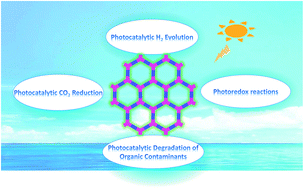Covalent organic frameworks: emerging high-performance platforms for efficient photocatalytic applications
Abstract
Covalent organic frameworks (COFs), as a new emerging class of highly crystalline advanced porous materials with fascinating structural tunability and diversity as well as the desired semiconductor properties, have gained significant attention as highly promising and efficient photocatalysts or designer platforms for a variety of photocatalytic applications in recent years; thus a comprehensive review is timely to summarize the advances of this field. In this review, a background and brief timeline concerning the developments and key achievements of COFs are provided. Afterwards, a systematic overview of the potential photocatalytic applications realized to date in the fast growing field of COFs is provided with the aim of presenting a full blueprint of COFs for possible photochemical energy conversion and reactions. Finally, the challenges remaining and personal perspectives on further development of this type of material for photocatalysis are presented.

- This article is part of the themed collections: 2020 Journal of Materials Chemistry A most popular articles and Journal of Materials Chemistry A Lunar New Year collection 2021


 Please wait while we load your content...
Please wait while we load your content...